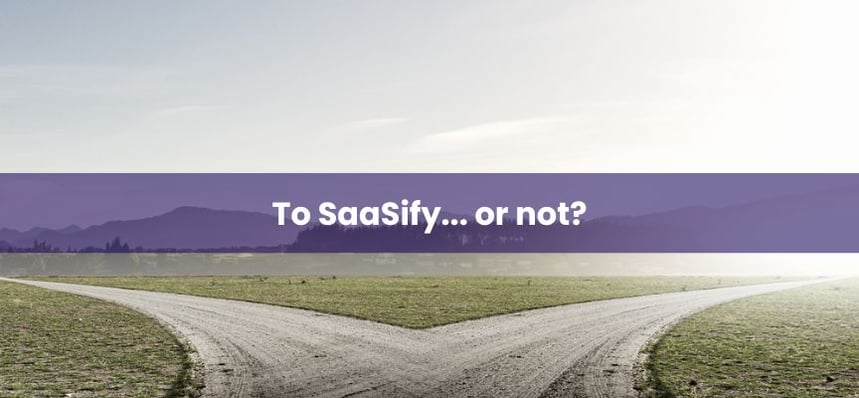The trend of SaaSification, or the migration of traditional, on-premises software to a cloud-based, subscription-based model, has gained traction in recent years. Migrating to SaaS has a ton of benefits, like increased accessibility and scalability, improved efficiency and cost savings, and enhanced security and data protection. These benefits are the primary drivers of the SaaSification trend, and companies of all sizes are recognizing them and taking advantage of this technology to improve their operations.
But with every advantage, there are also potential drawbacks to consider before making the decision to SaaSify your software product. SaaSification may not be right for every software product or business. That’s why we’re exploring the top reasons why you should SaaSify your software product, as well as the top reasons why you shouldn't do it.
Top 3 reasons to SaaSify your software product:
1) Increased flexibility and scalability
Migrating to a SaaS solution provides increased flexibility and scalability, enabling your business to adapt quickly to changing market conditions. This not only makes it easier for users to access and use the software, but it also helps businesses scale their operations and reach a wider audience. Instead of being locked into a rigid IT infrastructure, you can easily scale your application to meet the needs of your business.
With a SaaS solution, you can seamlessly add or remove users and functionality, without any disruption to your business. This enables you to respond quickly to changing market conditions and capitalize on new opportunities, without having to worry about the limitations of your IT infrastructure. Additionally, the pay-as-you-go model of SaaS solutions ensures that you only pay for what you use, helping you control costs and reduce waste. Ultimately, SaaS solutions provide your business with the flexibility to rapidly adjust and adapt, enabling you to stay ahead of the competition and take advantage of new opportunities.
2) Improved efficiency and happier users
SaaSification can lead to enhanced efficiency for both the provider and the user.
The provider benefits from easier and more cost-effective updates and maintenance. Updates can be rolled out quickly and easily, without the need for time-consuming and expensive individual installations.
For the user, the cost of hardware and on-premises infrastructure is reduced, as there is no need to make a large upfront investment in hardware and software licenses. They can take advantage of the latest technology without having to bear the costs associated with acquiring and maintaining their own infrastructure. Additionally, users also benefit from improved scalability and better performance. It's a win win!
3) Better financials and shorter sales cycles
Migrating to SaaS improves the visibility into revenue streams, making it easier to accurately predict income and make informed financial decisions.The recurring revenue model offered by most SaaS providers gives a clear and consistent source of income, allowing the business to make more accurate financial projections and create strategic plans with a greater degree of certainty.
Furthermore, the shorter sales cycles of SaaS products also ensure that income is generated quicker, making it easier to stay financially afloat and adapt quickly to changing market conditions.
Often times, SaaS products have pricing models that shorten traditionally longer sales cycles. SaaS solutions are typically subscription-based, decreasing upfront costs and the complexity of software acquisition. Not to mention the ability to demo and test software in a low-risk environment, a true catalyst to the sales process... Or a lower barrier to entry, as customers can sign up for a trial period to explore a product without feeling like they have made a major commitment.
The end result is a more efficient sales cycle that results in quicker revenue recognition and improved cash flow, supporting greater financial stability and sustainable growth.
Now, let's look the opposite way.
Top 3 reasons not to SaaSify your software product:
1) Loss of control
With the SaaS model, there will be a shift in how the software is used and accessed by users - which can result in a loss of control for you, the provider. Your customers may have more freedom to customize and configure the software in ways that you may not have intended or approved. This can potentially reduce the level of control you have over the product, which may limit your ability to ensure that the software is being used in a way that aligns with your vision and goals. Operating as SaaS can limit the provider's ability to dictate the software's usage and design.
As a provider, you must understand and consider the implications of your customers’ increased autonomy when deciding to switch from a traditional software model to SaaS. In order to protect your product and maintain a level of control, you must be willing to make some compromises.
2) Requires a change in culture
When a business decides to SaaSify its software, it also needs a cultural change towards increased agility, becoming more flexible and responsive to the changing needs of its clients and the marketplace. This requires an organizational shift from a focus on developing and maintaining software, to an increased emphasis on understanding customer needs and delivering a superior user experience.
For instance, the business might have operated using a hierarchical structure and a top-down decision-making process under the traditional software paradigm. However, with the SaaS model, the business must work more closely with stakeholders and customers at every stage of the product's lifecycle. This triggers a cultural shift within the organization as staff members must pick up new skills and adjust to a more flexible, customer-centric strategy.
The SaaSification process may be tough or perhaps fail if the firm is not ready to undertake this cultural change.
3) Long-term commitment
The SaaS model involves a long-term commitment, as users must pay a subscription fee to continue accessing the software. While this long-term commitment can give the software provider a steady and predictable source of income, it can also be a barrier for some users, especially if they are uncertain about the long-term value or usefulness of the software. To successfully implement the SaaSification process, a firm needs to be prepared for the long-term commitment and also be confident that their users will find value in using the software over an extended period of time.
SaaSification can be a powerful and effective way to transform a software product and take advantage of the benefits of cloud computing. But it's important to weigh in the potential pros and cons and whether it is the right fit for your business. Ultimately, the decision to SaaSify your software product should be based on a thorough analysis of your specific needs and goals. When embarking on the SaaSification process, a business should consider the long-term implications and potential benefits of making this transition.
At Kubeark, our mission is to help companies SaaSify, manage, monetize and scale their apps efficiently. We believe that SaaSification can bring numerous benefits and help businesses evolve their software products from traditional models, staying ahead in today’s competitive market. Discover the Kubeark platform here.

